Elements of a Digital Urbanisation Strategy for Türkiye: Evidence from Psychometric Testing
Abstract
1. Introduction
2. Theoretical Framework
2.1. Digital Society and Dilemmas Arising in Society–Space Relations
2.2. Digital Urbanism, Smart Governance and Grassroots-Based Strategies
3. Research Methodology, Data Collection and Analysis
3.1. Research Methodology and Methods
3.1.1. Psychometric Test
3.1.2. Psychometric Assessment
4. Results
4.1. Physical Space and Mental Space Dilemma
4.2. Sharing and Privacy Dilemma
4.3. Natural Body and Body Dependent on Digital Dilemma
4.4. Robust Places/Goods and Vulnerable Places/Goods Dilemma
4.5. Single-Function Space and Multi-Functional Space Dilemma
4.6. Natural Systems and Smart Systems Dilemma
5. Conclusions and Discussion
5.1. How Can the Relationship of Turkish Society with Space Be Best Shaped in the Process of Moving Towards a Digital Society?
5.2. What Are the Key Components of an Ideal Grassroots-Based Digital Urbanism Strategy for Türkiye?
- In Türkiye, people generally do not focus on the controlling and intrusive aspects of technology. They prefer the aspects of technology that make daily life easier. Therefore, the country’s strategy for digital urbanisation should focus on tech that boosts convenience, ramps up efficiency, and takes care of regular chores automatically.
- Although there is a general unease in Turkish society about personal data collection, this discomfort eases if individuals can control and manage their own information. Therefore, Türkiye’s strategy for digital urbanisation should protect personal data ownership and establish clear, honest policies for data gathering and usage.
- Turkish society emphasises that people are not machines but intelligent beings with feelings and thoughts. Thus, Türkiye’s digital urbanisation strategy should prioritise societal needs and aspirations, adopting a human-focused approach.
- Recognising that cities evolve through the contributions of their inhabitants, Turkish society suggests that Türkiye’s digital urbanisation strategy should be adaptable and flexible, catering to the ever-changing demands and technologies of urban life.
- Believing that cities are places where diversity thrives, Turkish society recommends that Türkiye’s digital urbanisation strategy should aim to foster an environment where different cultures and lifestyles coexist, creating a sense of belonging for all.
- Turkish society views cities as arenas of interaction, exploration, freedom, and opportunity. Hence, Türkiye’s digital urbanisation strategy should encourage creativity and innovation, supporting the development and exchange of fresh ideas within urban areas.
- Understanding that cities, people, communities, and civilisations have their own stories, Turkish society advises that Türkiye’s digital urbanisation strategy should connect individuals with their heritage and ensure the city’s narrative is preserved for the future.
- Aware that cities are part of the natural world, Turkish society suggests that Türkiye’s digital urbanisation strategy should integrate eco-friendly technologies and aim to create a sustainable urban environment.
5.3. Limitations of the Study
Author Contributions
Funding
Institutional Review Board Statement
Informed Consent Statement
Data Availability Statement
Conflicts of Interest
Appendix A. Document Analysis
| Digitalisation | Digital Urbanism | Digital Society and Smart Governance | Grassroots-Based Strategy |
|---|---|---|---|
| Ash et al. (2018) | Barns (2018) | Angelidou (2014) | Leszczynski (2018) |
| Cureton (2022) | Chiappini (2020) | Shelton et al. (2015) | Vadiati (2022) |
| Datta (2018) | Coletta et al. (2017) | De Hoop et al. (2021) | Sinclair and Bramley (2011) |
| Runnel et al. (2013) | Moss et al. (2021) | Azzari et al. (2018) | Li et al. (2022) |
| Chiappini (2020) | Kitchin and Lauriault (2018) | Redshaw (2020) | Schwarz (2021) |
| Harvey (2012) | Kitchin et al. (2015) | Andrushchenko et al. (2022) | Fuchs (2022) |
| Levin and Mamlok (2021) | Vadiati (2022) | Mütterlein and Fuchs (2019) | Nassehi (2024) |
| Legner et al. (2017) | Barns (2018) | De Vos (2020) | Frantz et al. (2020) |
| Judijanto et al. (2024) | Leszczynski (2018) | Thouvenin et al. (2018) | Feldstein (2021) |
| Dufva and Dufva (2019) | Rosenblat (2018) | Vervier et al. (2017) | |
| Sokolov et al. (2019) | Lyons et al. (2018) | ||
| Rubio and Wharton (2020) | |||
| Corbet et al. (2019) | |||
| Mondejar et al. (2021) |
Appendix B. In-Depth Interviews with Experts
| Respondent Code | Profession | Age Range | Gender | Education Background | Years of Working Experience | Field of Expertise |
|---|---|---|---|---|---|---|
| G1 | Chairman of the Futurists Association High Advisory Board | 40–50 | Male | Industrial Engineering | 21 | Digital strategy, development of digital assets, digital transformation, digital urbanism |
| G2 | Member of the Supervisory Board of the Futurists Association | 50–60 | Male | Entrepreneurship | 35 | Entrepreneurship, market research and analysis, futurism, digitalisation |
| G3 | Young Futurists Chairman of the Board | 30–40 | Female | Political Science and International Relations | 12 | Blockchain, sustainability, web3, futurism, digital leadership, management and organisation, digital society |
| G4 | Industry 4.0 Digital Transformation Association Project Coordinator | 50–60 | Male | Industrialist | 32 | Industry 4.0, industry–university–private sector ecosystem, digital transformation, digitalisation |
| G5 | Software engineer | 40–50 | Female | Software Engineering | 18 | Advanced technology solutions, global software services, telecommunications, smart city |
| G6 | Futurist and Strategist | 50–60 | Male | Strategy Expert | 37 | Internet, media, and information technologies, international strategic analysis, platform urbanism |
| G7 | Researcher, Author, and Trainer | 50–60 | Male | Nuclear Energy Engineering | 35 | Quantum physics and time, mythology, paganism, digital society |
| G8 | Strategist and futurist | 60–70 | Male | Electrical Electronics Engineering | 37 | Futurism, storytelling, strategy development, digital transformation, smart governance |
| G9 | Film producer, screenwriter, and director | 60–70 | Male | Education and Linguistics | 27 | Creative content production, scriptwriting, digitalisation, futurism, grassroots-based strategy |
| G10 | Academician and Author | 50–60 | Female | Political Science and International Relations | 37 | International relations, terrorism and security, political psychology, smart governance |
| G11 | Strategic Communications Consultant | 60–70 | Male | Journalism and Public Relations | 46 | Strategic communication, reputation management, corporate social responsibility, grassroots-based strategy |
| G12 | Journalist and Writer | 70–80 | Male | Journalism and Public Relations | 42 | Sociology, history, politics, grassroots-based strategy |
| G13 | Environmental Scientist | 40–50 | Male | Geological Engineering | 30 | Ecology, conservation biology, economics, system theory, complexity, platform urbanism |
- What is your individual, social and spatial predictions about the cities of the future?
- What dimension do you think the society–space relationship will gain in the near future?
- In what ways will the technologies of the near future enter the cities (indoor and outdoor) and the daily life of individuals?
- How are the smart technologies produced today integrated into the space?
- What dilemmas will people be stuck between in the cities of the near future, indoors and outdoors? What choices will people be forced to make?
- In what way and how will the smart technologies of the future change people’s lifestyles?
- How will the interior and exterior spaces be shaped and used in the near future?
- What kind of demands will people have in indoor and outdoor spaces in the cities of the near future?
- What could be the dark sides of technology to which Turkish society will react negatively and act shyly?
Appendix C. Content Analysis
| Text Type | Paragraph/Quote | Exploration of Dilemma | Explanation of Dilemma | Tendency/Preference in Psychometric Analysis |
|---|---|---|---|---|
| Written Text | “Real space is the nature, the cosmos, the physical space on which one lives. Mental space, which includes logical and formal abstractions, is imagined space. The primary space is real and the secondary space is imaginary” (Barns 2018) | Physical Space and Mental Space | “Spatial attachment refers to the ties that people share with places” (Vadiati 2022) | Participants’ commitment to the physical place |
| Verbal Text | “When digital memory is articulated with tangible and physical space, memory comes to life in a space. Technology allows space to cumulatively store individual and social memory. Some places now have a digital memory.” From the interviews | Sharing and Privacy | “Having your data in the hands of others, such as the government or a company, may be harmful to democracy and human rights.” From the interviews | Participants’ view about storage of personal data by places and objects |
Appendix D. Questions in the Psychometric Test
| Being physically and mentally in this place right now | QUESTION 1 1 2 3 4 5 6 | Being physically in this place now and mentally in another place |
| Physically visiting the place, you want to visit | QUESTION 2 1 2 3 4 5 6 | Mentally visiting the place, you want to visit |
| Physically going to the required place to perform an activity | QUESTION 3 1 2 3 4 5 6 | Performing an activity in a virtual space |
| Being physically and mentally in a single environment, being completely there and feeling it | QUESTION 4 1 2 3 4 5 6 | Being physically and mentally in a semi-virtual/semi-real environment interacting with all abstract/concrete elements |
| Living with the tangible and real | QUESTION 5 1 2 3 4 5 6 | Living with the abstract and the virtual |
| Existence of limiting factors such as time, place, work, school to travel | QUESTION 6 1 2 3 4 5 6 | Being able to travel virtually wherever and whenever you want |
| Expressing the contemporary equivalents of the concepts of distance and proximity | QUESTION 7 1 2 3 4 5 6 | Far is near and near is far |
| Maintaining all social relations face to face | QUESTION 8 1 2 3 4 5 6 | Maintaining all social relations without being in the same environment with people |
| Ensuring communication by phone and video call | QUESTION 9 1 2 3 4 5 6 | Providing communication with hologram technology |
| A doctor’s surgery on a person in the place where s/he is physically present | QUESTION 10 1 2 3 4 5 6 | Remote surgery on a person in another part of the world, different from the place where a doctor is |
| Walking somewhere | QUESTION 11 1 2 3 4 5 6 | Getting the destination to our feet |
| Physically going to school | QUESTION 12 1 2 3 4 5 6 | Being in school mentally while being in another place physically |
| Same country where you live and work | QUESTION 13 1 2 3 4 5 6 | The country you work in is different from the country you live in |
| Same city where you live and work | QUESTION 14 1 2 3 4 5 6 | The city you work in is different from the city you live in |
| The place cannot not keep (store) your personal data | QUESTION 15 1 2 3 4 5 6 | The place can keep (store) your personal data |
| Protection and confidentiality of information about you | QUESTION 16 1 2 3 4 5 6 | Sharing information about you transparently with everyone |
| Only you have the right to access your data | QUESTION 17 1 2 3 4 5 6 | Persons and institutions that you give permission to have access to your data |
| Your spatial behaviour data is not recorded and measured | QUESTION 18 1 2 3 4 5 6 | Regular recording and analysis of your spatial behaviour data |
| Items are passive and have only functions to meet current needs | QUESTION 19 1 2 3 4 5 6 | Items are active in use of personal information to provide services |
| Using technology within private and secure limits | QUESTION 20 1 2 3 4 5 6 | Benefiting from all the benefits of technology in a transparent and sharing way |
| Effortlessly accessing knowledge about the physical environment through personal experience | QUESTION 21 1 2 3 4 5 6 | Digital and ready availability of information about the physical environment always |
| Keeping the body in its natural state | QUESTION 22 1 2 3 4 5 6 | Attaching a technological apparatus to the body |
| The movement of the individual according to the place s/he is in | QUESTION 23 1 2 3 4 5 6 | Changing the shape of the space depending on the body movements of the individual |
| The ability of your body to move in its natural state as independent of space | QUESTION 24 1 2 3 4 5 6 | Establishing a kind of digital connection between your body and space |
| The fact that technological tools are in today’s dimensions and portable | QUESTION 25 1 2 3 4 5 6 | Integration of technological tools into the human body in micro dimensions |
| Carrying objects that provide continuous data flow out of your body | QUESTION 26 1 2 3 4 5 6 | Carrying objects that provide continuous data flow into your body |
| Always have the control of your personal mind and will in the space you are in. | QUESTION 27 1 2 3 4 5 6 | Temporarily leaving personal mind and will control to a smarter device/robot in the space you are in |
| Doing daily chores by oneself | QUESTION 28 1 2 3 4 5 6 | Basic daily work done by artificial intelligence and robots |
| Having a large, spacious, built-in home | QUESTION 29 1 2 3 4 5 6 | Having a portable home that is small enough to meet your needs |
| Covering the contactable parts of the living and working environment with hard and durable surfaces | QUESTION 30 1 2 3 4 5 6 | Covering the touchable parts of the living and working environment with soft, sensitive, digital surfaces |
| Having a traditional, permanent, unchanging house type | QUESTION 31 1 2 3 4 5 6 | To have a house type that can be expanded and changed according to demand and need |
| The walls and ceiling of the place to be fixed | QUESTION 32 1 2 3 4 5 6 | The walls and ceiling of the place can be moved and relocated according to demand and need. |
| Cultivating certain vegetables and fruits on certain lands and offering them to the public through markets | QUESTION 33 1 2 3 4 5 6 | Having common agricultural areas where everything can be grown |
| Having workplaces separate from home | QUESTION 34 1 2 3 4 5 6 | Working places inside the house, designing it together with the home |
| The working place is single, limited and within the rules. | QUESTION 35 1 2 3 4 5 6 | Multiple, unlimited, and flexible rules in every sense of the workplace |
| The place where you live, and work is fixed | QUESTION 36 1 2 3 4 5 6 | Moving and changing the place where you live and work |
| Preserving and maintaining the habitual established spatial order | QUESTION 37 1 2 3 4 5 6 | Using it by changing the spatial layout |
| Realization of living, working and entertainment in different physical environments/spaces | QUESTION 38 1 2 3 4 5 6 | Living, working, and having fun in the same physical environment/space |
| Holding business meetings in your own spaces | QUESTION 39 1 2 3 4 5 6 | Holding business meetings in constantly changing and rented venues |
| Cities where physical/bodily actions are dominant and intense | QUESTION 40 1 2 3 4 5 6 | Cities where mental acts are dominant and intense |
| The need for bodily movement to access physical spaces | QUESTION 41 1 2 3 4 5 6 | Accessing digital spaces with mental movement |
| Permanently owning a place | QUESTION 42 1 2 3 4 5 6 | Using the properties, you do not own by subscribing or renting |
| Having your own home | QUESTION 43 1 2 3 4 5 6 | Living in homes that do not belong to you with a subscription or term rental system |
| Having your own vehicle | QUESTION 44 1 2 3 4 5 6 | Using a car that does not belong to you with a subscription or term rental system |
| Continuation of passport and visa applications for international travels | QUESTION 45 1 2 3 4 5 6 | Removal of passport and visa applications for international travels |
| Use of currency that varies between countries | QUESTION 46 1 2 3 4 5 6 | Use of a single currency valid worldwide |
| Value judgments that change from society to society, from culture to culture | QUESTION 47 1 2 3 4 5 6 | Universal value judgments |
| Being responsible for everything in the house | QUESTION 48 1 2 3 4 5 6 | Delegation of responsibility for everything in the house to smart devices and robots |
| Energy saving and recycling by individuals | QUESTION 49 1 2 3 4 5 6 | Energy saving and recycling by smart buildings |
| Being in control of traffic | QUESTION 50 1 2 3 4 5 6 | Control in traffic by driverless, autonomous vehicles |
| Objects are independent of each other and only related to their own functions | QUESTION 51 1 2 3 4 5 6 | Objects being connected and interacting with each other |
| A life without internet | QUESTION 52 1 2 3 4 5 6 | A life with unlimited internet |
| Deciding by yourself | QUESTION 53 1 2 3 4 5 6 | Everything is decided by artificial intelligence that knows you completely and knows what you like and don’t like. |
| Progress of social relations by meeting one-on-one | QUESTION 54 1 2 3 4 5 6 | Obtaining information about people through a general scoring system in social relations |
| Going to a certain place personally, communicating with the employees face to face and following the process personally | QUESTION 55 1 2 3 4 5 6 | Handling the processes by devices/robots with artificial intelligence |
| Having authority and decision-making power in humans | QUESTION 56 1 2 3 4 5 6 | Having the authority and decision-making authority in robots with artificial intelligence |
| Informing local government in person orally or in writing about your opinions on the city you live in | QUESTION 57 1 2 3 4 5 6 | Obtaining your opinions on the city you live in through digital data belonging to you by local government |
| Collecting and processing human-made data in the urban planning process | QUESTION 58 1 2 3 4 5 6 | Collection of digital data and processing of data by artificial intelligence in the urban planning process |
References
- Andrushchenko, Victor, Irina Yershova-Babenko, Dina Kozobrodova, Anna Seliverstova, and Irina Lysakova. 2022. Digitalization of society: Implications and perspectives in the context of the psycho-dimensionality of social reality/psychosynertics. Amazonia Investiga 11: 183–95. [Google Scholar] [CrossRef]
- Angelidou, Margarita. 2014. Smart city policies: A spatial approach. Cities 41: 3–11. [Google Scholar] [CrossRef]
- Ash, James, Rob Kitchin, and Agnieszka Leszczynski. 2018. Digital turn, digital geographies? Progress in Human Geography 42: 25–43. [Google Scholar] [CrossRef]
- Azzari, Margherita, Chiara Garau, Paolo Nesi, Michela Paolucci, and Paola Zamperlin. 2018. Smart city governance strategies to better move towards a smart urbanism. In Computational Science and Its Applications–ICCSA 2018: 18th International Conference, Melbourne, VIC, Australia, July 2–5. Proceedings, Part III 18. Cham: Springer International Publishing, pp. 639–53. [Google Scholar]
- Barns, Sarah. 2018. Platform urbanism rejoinder: Why now? What now. Mediapolis. A Journal of Cities and Culture 3. [Google Scholar]
- Chiappini, Letizia. 2020. The urban digital platform: Instances from Milan and Amsterdam. Urban Planning 5: 277–88. [Google Scholar] [CrossRef]
- Coletta, Claudio, Liam Heaphy, Sung Yueh Perng, and Laurie Waller. 2017. Data-driven cities? Digital urbanism and its proxies: Introduction. TECNOSCIENZA: Italian Journal of Science & Technology Studies 8: 5–18. [Google Scholar]
- Corbet, Heidi, Ian Caldwell, Ian Goodfellow, Michael Riebel, and Oliver Milton. 2019. Changing Spaces. In Future Campus. London: RIBA Publishing, pp. 29–37. [Google Scholar]
- Cripps, Barry. 2017. Psychometric Testing: Critical Perspective. West Sussex: John Wiley & Sons. [Google Scholar]
- ÇŞİDB. 2024. Türkiye National Smart Cities Strategy and Action Plan. Republic of Türkiye Ministry of Environment, Urbanization and Climate Change. Available online: https://www.akillisehirler.gov.tr/wp-content/uploads/2023/12/Taslak-Eylem_Plani.pdf (accessed on 11 September 2024).
- Cureton, Paul. 2022. Augmented Reality: Robotics, Urbanism and the Digital Turn. In The Palgrave Encyclopedia of Urban and Regional Future. Cham: Palgrave Macmillan. [Google Scholar] [CrossRef]
- Datta, Ayona. 2018. The digital turn in postcolonial urbanism: Smart citizenship in the making of India’s 100 smart cities. Transactions of the Institute of British Geographers 43: 405–19. [Google Scholar] [CrossRef]
- Datta, Ayona. 2023. The digitalising state: Governing digitalization-as-urbanization in the global south. Progress in Human Geography 47: 141–59. [Google Scholar] [CrossRef]
- De Hoop, Evelien, Timothy Moss, Adrian Smith, and Emanuel Löffler. 2021. Knowing and governing smart cities: Four cases of citizen engagement with digital urbanism. Urban Governance 1: 61–71. [Google Scholar] [CrossRef]
- De Vos, Jan. 2020. The Digitalization of (Inter) Subjectivity: A Psy-Critique of the Digital Death Drive. London: Routledge. [Google Scholar]
- DeVon, Holli A., Michelle E. Block, Patricia Moyle-Wright, Diane M. Ernst, Susan J. Hayden, Deborah J. Lazzara, Suzanne M. Savoy, and Elizabeth Kostas-Polston. 2007. A psychometric toolbox for testing validity and reliability. Journal of Nursing Scholarship 39: 155–64. [Google Scholar] [CrossRef]
- DiCerbo, Kristen E., Valerie Shute, and Yoon Jeon Kim. 2017. The future of assessment in technology rich environments: Psychometric considerations. In Learning, Design, and Technology: An International Compendium of Theory, Research, Practice, and Policy. Cham: Springer International Publishing, pp. 1–21. [Google Scholar] [CrossRef]
- DTO. 2024. Türkiye Digital State Strategy & National Artificial Intelligence Strategy. Presidency of the Republic of Türkiye Digital Tranformation Office. Available online: https://cbddo.gov.tr/en/ (accessed on 11 September 2024).
- Dufva, Tomi, and Mikko Dufva. 2019. Grasping the future of the digital society. Future 107: 17–28. [Google Scholar] [CrossRef]
- Eren, Fatih. 2016. The re-specification of concepts in the morphogenetic approach for property market research. ICONARP International Journal of Architecture and Planning 4: 15–34. [Google Scholar] [CrossRef]
- Eren, Fatih, and John Henneberry. 2021. The glocalisation’ of Istanbul’s retail property market. Journal of European Real Estate Research 15: 278–94. [Google Scholar] [CrossRef]
- Feldstein, Steven. 2021. The Rise of Digital Repression: How Technology Is Reshaping Power, Politics, and Resistance. Oxford: Oxford University Press. [Google Scholar]
- Frantz, Erica, Andrea Kendall-Taylor, and Joseph Wright. 2020. Digital repression in autocracies. Varieties of Democracy Institute Users Working Paper 27: 1–22. [Google Scholar]
- Fuchs, Christian. 2022. Digital Humanism: A Philosophy for 21st Century Digital Society. Bingley: Emerald Group Publishing Limited. [Google Scholar]
- Hahn, Kornelia. 2021. Social Digitalization: Persistent Transformations Beyond Digital Technology. New York: Springer Nature. [Google Scholar]
- Hammond, Sean. 2006. Using psychometric tests. Research Methods in Psychology 3: 182–209. [Google Scholar]
- Harvey, David. 2012. Rebel Cities: From the Right to the City to the Urban Revolution. London: Verso Books. [Google Scholar]
- Judijanto, Loso, Mei Rani Amalia, Arief Fahmi Lubis, and Weda Febriyanto. 2024. Cultural Transformation through Digitalization: A Bibliometric Approach in Responding to Changes in Social Values, Norms, and Cultural Practices in Society. West Science Social and Humanities Studies 2: 1366–76. [Google Scholar] [CrossRef]
- Kitchin, Rob, and Tracey Lauriault. 2018. Data and data infrastructures. Digital Geographies, 83–94. [Google Scholar]
- Kitchin, Rob, Tracey P. Lauriault, and Gavin McArdle. 2015. Knowing and governing cities through urban indicators, city benchmarking and real-time dashboards. Regional Studies, Regional Science 2: 6–28. [Google Scholar] [CrossRef]
- Lane, Jeffrey. 2018. The Digital Street. Oxford: Oxford University Press. [Google Scholar]
- Legner, Christine, Torsten Eymann, Thomas Hess, Christian Matt, Tilo Böhmann, Paul Drews, Alexander Mädche, Nils Urbach, and Frederik Ahlemann. 2017. Digitalization: Opportunity and challenge for the business and information systems engineering community. Business & Information Systems Engineering 59: 301–8. [Google Scholar] [CrossRef]
- Leszczynski, Agnieszka. 2018. Digital methods I: Wicked tensions. Progress in Human Geography 42: 473–81. [Google Scholar] [CrossRef]
- Levin, Ilya, and Dan Mamlok. 2021. Culture and society in the digital age. Information 12: 68. [Google Scholar] [CrossRef]
- Li, Junjie, Guohui Zhan, Xin Dai, Meng Qi, and Bangfan Liu. 2022. Innovation and optimization logic of grassroots digital governance in China under digital empowerment and digital sustainability. Sustainability 14: 16470. [Google Scholar] [CrossRef]
- Lub, Vasco, and Vasco Lub. 2018. Watch Group 2: Countering Burglars. In Neighbourhood Watch in a Digital Age: Between Crime Control and Culture of Control. Cham: Palgrave Macmillan, pp. 57–72. [Google Scholar]
- Lyons, Glenn, Patricia Mokhtarian, Martin Dijst, and Lars Böcker. 2018. The dynamics of urban metabolism in the face of digitalization and changing lifestyles: Understanding and influencing our cities. Resources, Conservation and Recycling 132: 246–57. [Google Scholar] [CrossRef]
- Mellett, Edward. 2019. The Complete Guide to Psychometric Tests. Practice Reasoning. Available online: https://practicereasoningtests.com/psychometric-tests/ (accessed on 12 September 2024).
- Mondejar, Maria E., Ram Avtar, Heyker Lellani Banos Diaz, Rama Kant Dubey, Jesus Esteban, Abigail Gómez-Morales, and Sergi Garcia-Segura. 2021. Digitalization to achieve sustainable development goals: Steps towards a Smart Green Planet. Science of The Total Environment 794: 148539. [Google Scholar] [CrossRef]
- Moss, Timothy, Friederike Voigt, and Sören Becker. 2021. Digital urban nature: Probing a void in the smart city discourse. City 25: 255–76. [Google Scholar] [CrossRef]
- Mulder, Ingrid, Tomasz Jaskiewicz, and Nicola Morelli. 2019. On digital citizenship and data as a new commons: Can we design a new movement? Cuadernos del Centro de Estudios en Diseño y Comunicación Ensayo 73: 96–108. [Google Scholar] [CrossRef]
- Murray, Padmini Ray, and Ayona Datta. 2020. WIKI-URBANISM. In Urban Platforms and the Future City: Transformations in Infrastructure, Governance, Knowledge and Everyday Life. London: Routledge. [Google Scholar]
- Mütterlein, Joshchka, and Christoph Fuchs. 2019. Digital Technologies and Their Influence on Spaces. Paper presented at Twenty-Third Pacific Asia Conference on Information Systems, Xi’an, China, July 8–12; p. 126. [Google Scholar]
- Nassehi, Armin. 2024. Patterns: Theory of the Digital Society. Hoboken: John Wiley & Sons. [Google Scholar]
- NFKU. 2024. Türkiye’nin Bölgeleri İngilizce Tanıtım. Available online: https://www.nkfu.com/turkiyenin-bolgeleri-ingilizce-tanitimlari-ingilizce-haritalari/ (accessed on 12 September 2024).
- OECD. 2023. Digital Government Review of Türkiye: Towards a Digitally-Enabled Government. OECD Digital Government Studies. Paris: OECD Publishing. [Google Scholar] [CrossRef]
- Park, Joon, and Seungho Yoo. 2023. Evolution of the smart city: Three extensions to governance, sustainability, and decent urbanization from an ICT-based urban solution. International Journal of Urban Sciences 27 Suppl. S1: 10–28. [Google Scholar] [CrossRef]
- Ray, Sthitapragyan, and Neha Ojha. 2024. Globalisation, Technology, Media, and Social Movements. In Exploring Social Movements. London: Routledge India, pp. 307–25. [Google Scholar]
- Redshaw, Tom. 2020. What Is Digital Society? Reflections on the Aims and Purpose of Digital Sociology. Sociology 54: 425–31. [Google Scholar] [CrossRef]
- Rosenblat, Alex. 2018. Uberland: How Algorithms Are Rewriting the Rules of Work. Oakland: University of California Press. [Google Scholar]
- Rubio, Fernando Dominguez, and Glenn Wharton. 2020. The work of art in the age of digital fragility. Public Culture 32: 215–45. [Google Scholar] [CrossRef]
- Runnel, Pille, Pille Pruulmann-Vengerfeldt, Piret Viires, and Marin Laak. 2013. The Digital Turn: User’s Practices and Cultural Transformations. Oxford: Peter Lang. [Google Scholar]
- Schwarz, Ori. 2021. Sociological Theory for Digital Society: The Codes That Bind Us Together. Hoboken: John Wiley & Sons. [Google Scholar]
- Shelton, Taylor, Matthew Zook, and Alan Wiig. 2015. The actually existing smart city. Cambridge Journal of Regions, Economy and Society 8: 13–25. [Google Scholar] [CrossRef]
- Sinclair, Stephen, and Glen Bramley. 2011. Beyond Virtual Inclusion—Communications Inclusion and Digital Divisions. Social Policy and Society 10: 1–11. [Google Scholar] [CrossRef]
- Sokolov, Alexander, Natalia Veselitskaya, Vicente Carabias, and Onur Yildirim. 2019. Scenario-based identification of key factors for smart cities development policies. Technological Forecasting and Social Change 148: 119729. [Google Scholar] [CrossRef]
- Spath, Dieter, Jürgen Gausemeier, Roman Dumitrescu, Johannes Winter, Steffen Steglich, and M. Drewel. 2022. Digitalization of Society. In Handbook of Engineering Systems Design. Cham: Springer International Publishing, pp. 165–87. [Google Scholar]
- Tan, Gordon Kuo Siong. 2022. Citizens go digital: A discursive examination of digital payments in Singapore’s Smart Nation project. Urban Studies 59: 2582–98. [Google Scholar] [CrossRef]
- Terras, Melissa M. 2011. The rise of digitization: An overview. In Digitisation Perspectives. New York: Springer Nature, pp. 1–20. [Google Scholar]
- Thouvenin, Florent, Peter Hettich, Herbert Burkert, and Urs Gasser. 2018. Remembering and Forgetting in the Digital Age. New York: Springer, vol. 38. [Google Scholar]
- Vadiati, Niloufar. 2022. Alternatives to smart cities: A call for consideration of grassroots digital urbanism. Digital Geography and Society 3: 100030. [Google Scholar] [CrossRef]
- Valenduc, Gerard, and Patricia Vendramin. 2017. Digitalization, between disruption and evolution. Transfer: European Review of Labour and Research 23: 121–34. [Google Scholar] [CrossRef]
- Vervier, Luisa, Eva-Maria Zeissig, Chantal Lidynia, and Martina Ziefle. 2017. Perceptions of Digital Footprints and the Value of Privacy. Paper presented at the 2nd International Conference on Internet of Things, Big Data and Security, IoTBDS 2017, Porto, Portugal, April 24–26; pp. 80–91. [Google Scholar]
- Zhao, Yang, Zongyu Song, Jian Chen, and Wei Dai. 2023. The mediating effect of urbanization on digital technology policy and economic development: Evidence from China. Journal of Innovation & Knowledge 8: 100318. [Google Scholar] [CrossRef]


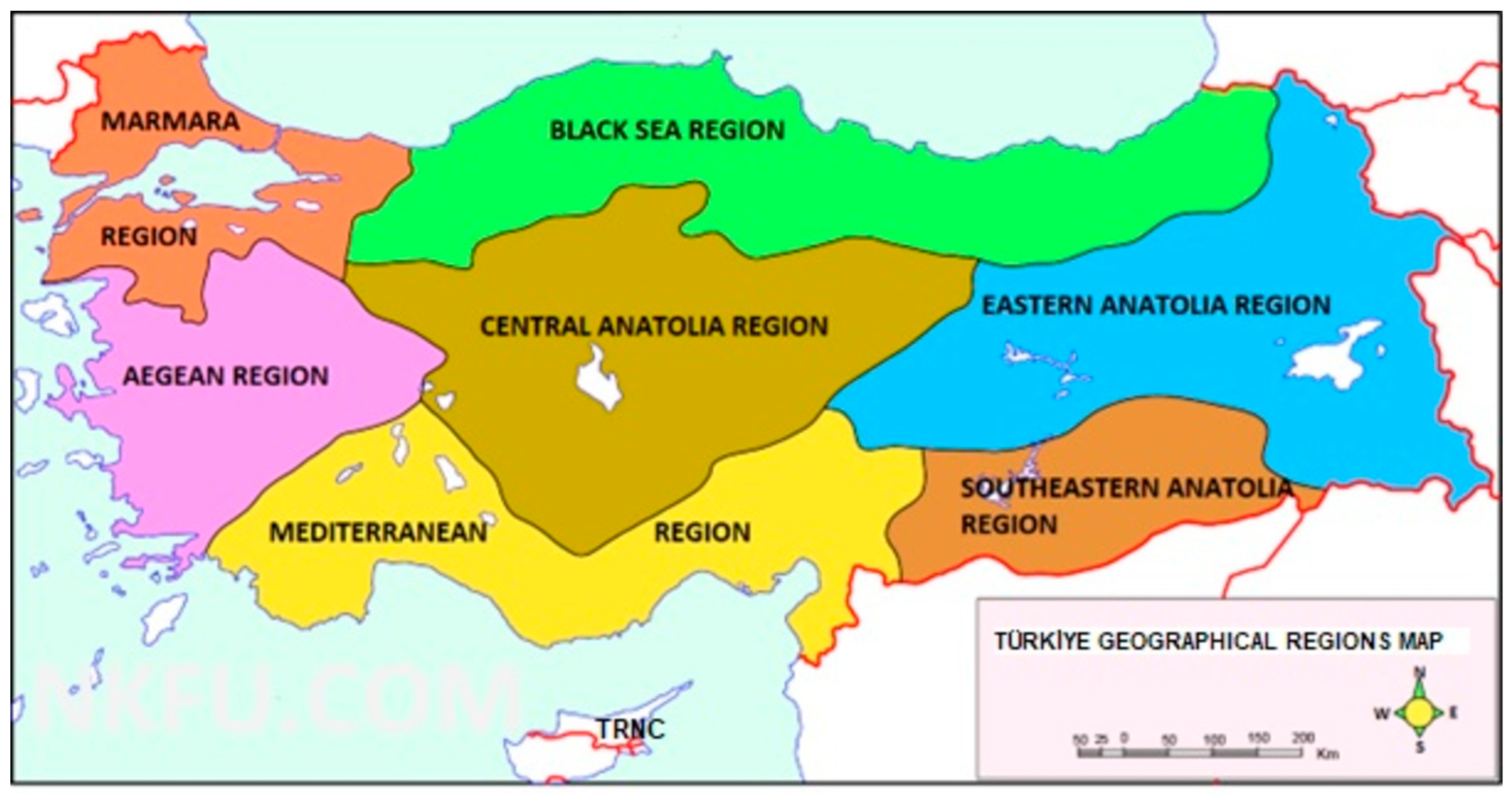

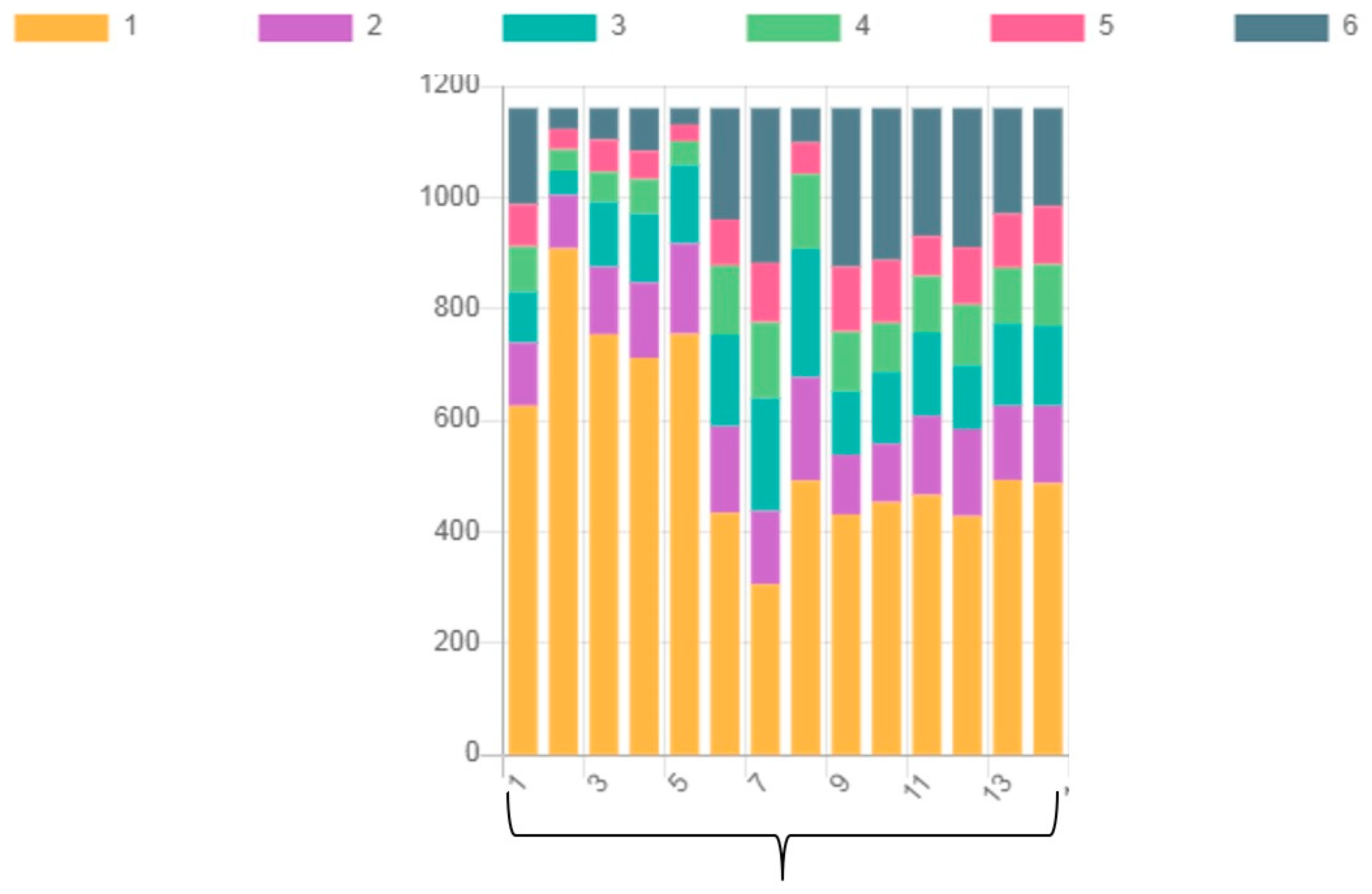

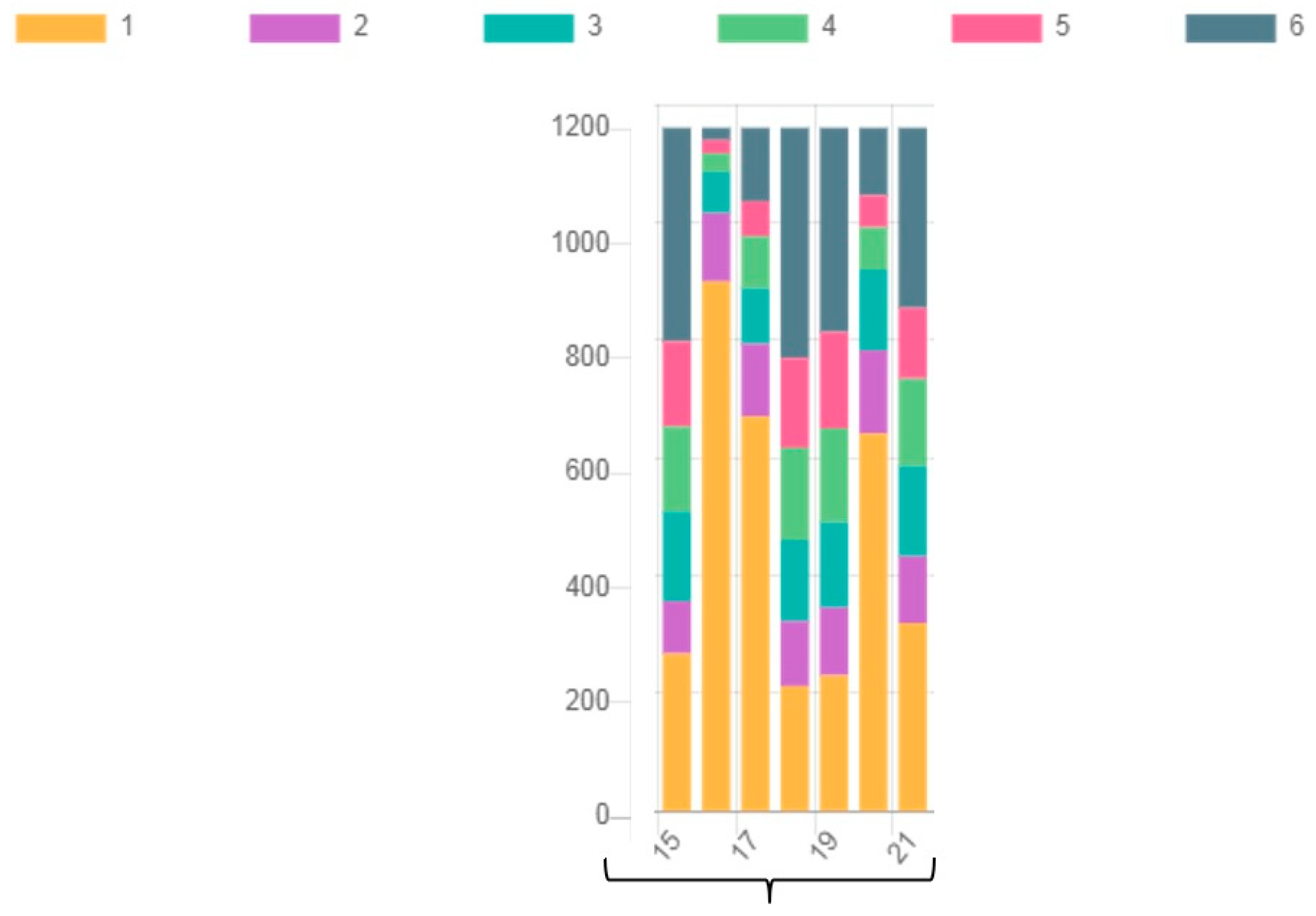



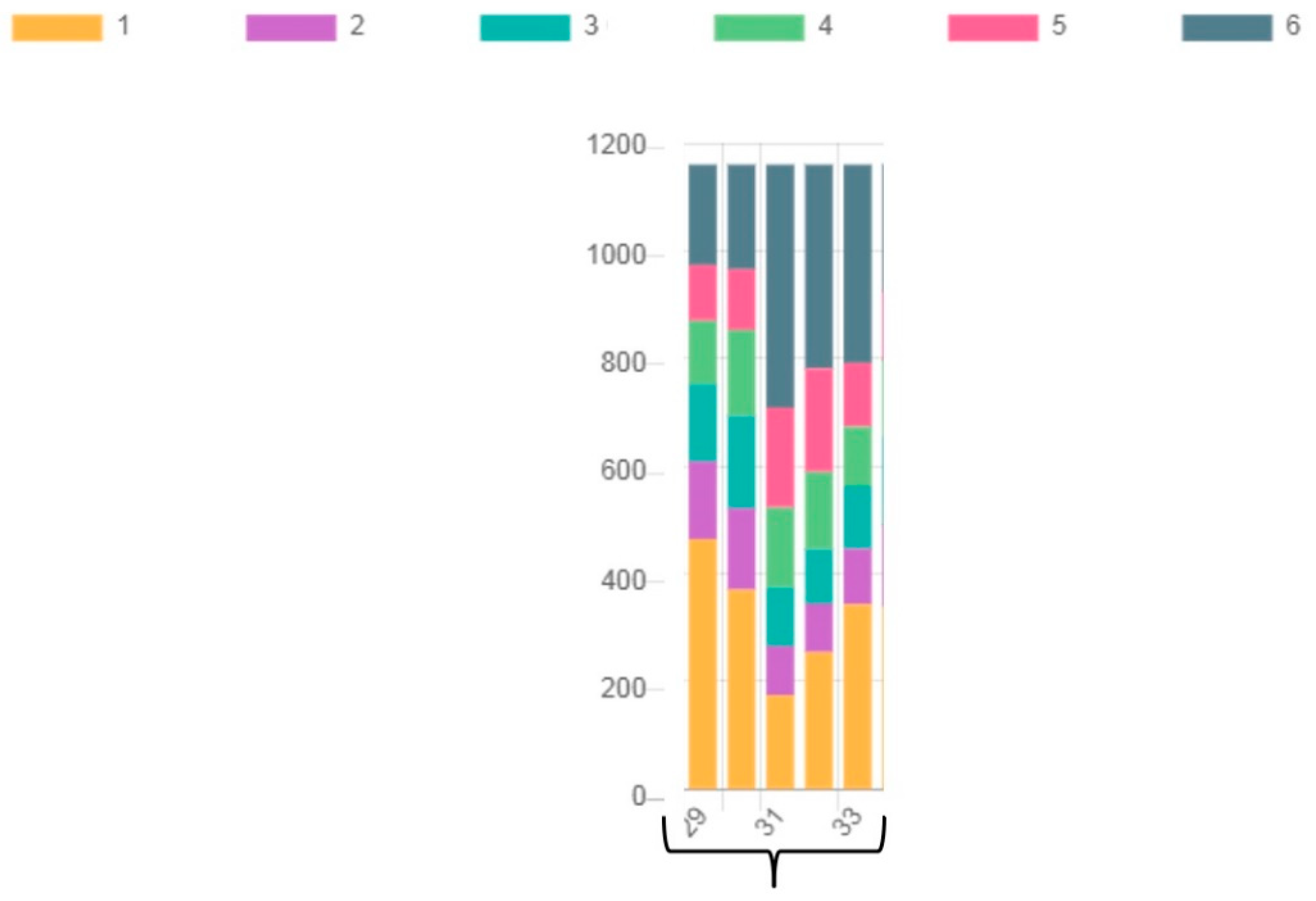

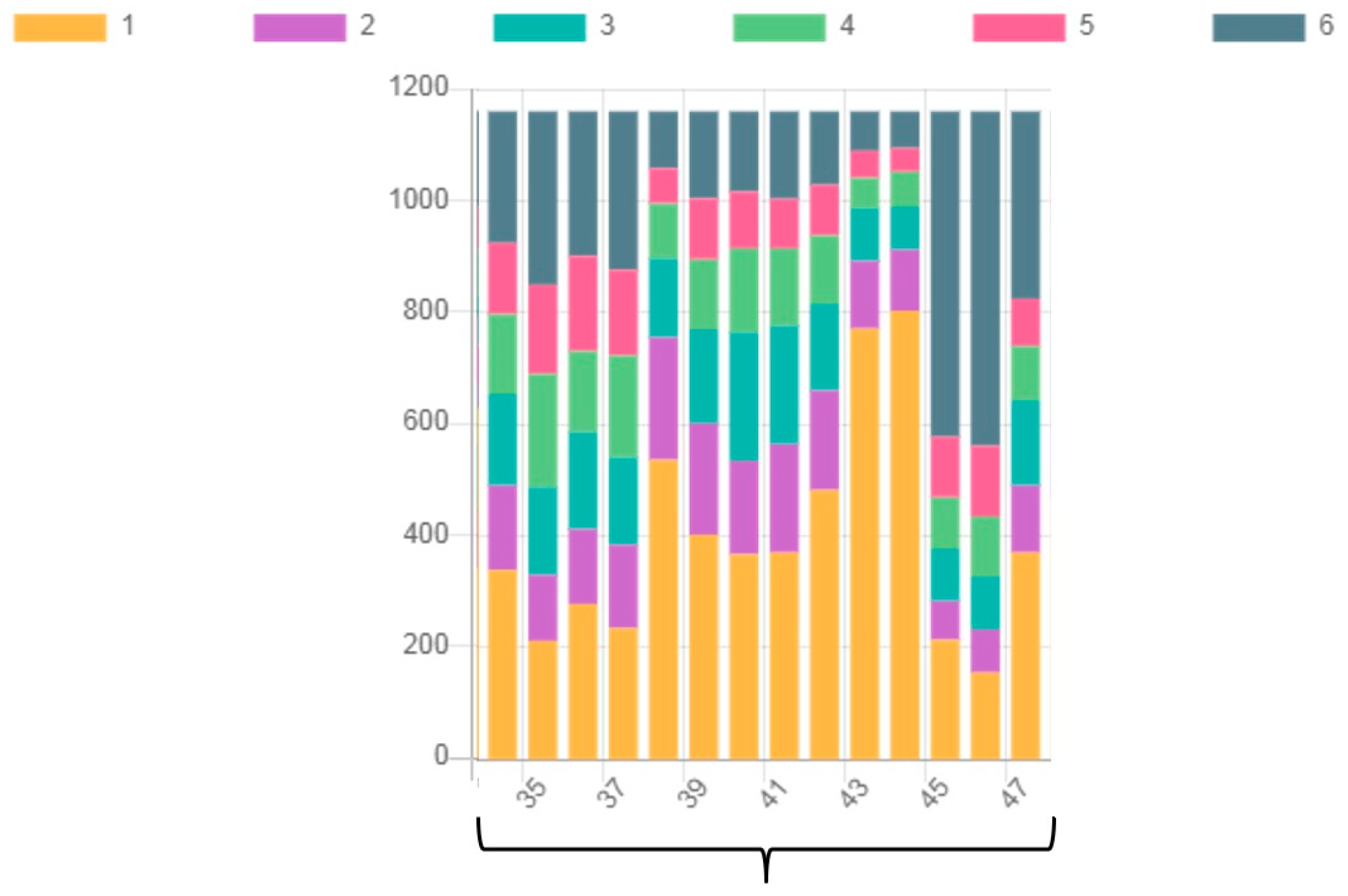

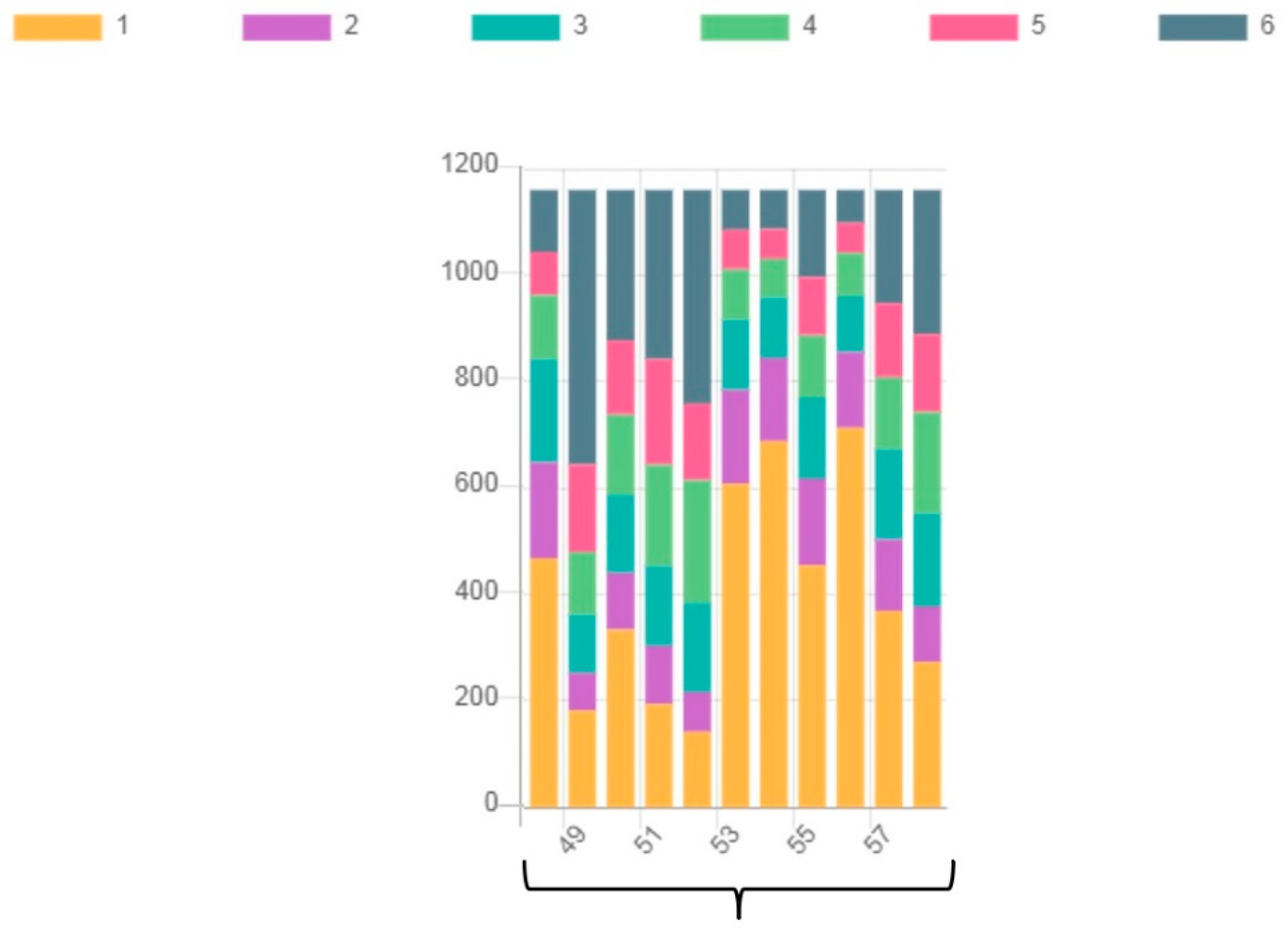

| Dilemma | Psychometric Analysis | Number of Questions |
|---|---|---|
| Physical Space and Mental Space | Participants’ commitment to the physical place | 14 |
| Sharing and Privacy | Participants’ view on storage of personal data by places and objects | 7 |
| Natural Body and Body Dependent on Digital | The relationship of the participants’ bodies with place and objects | 7 |
| Robust Places/Goods and Vulnerable Places/Goods | Durability of the place and goods used by the participants | 5 |
| Single-Function Space and Multi-Functional Space | How the participants use the place and for what | 14 |
| Natural Systems and Smart Systems | The significance of technology in participants’ lives | 11 |
| Total | 58 | |
Disclaimer/Publisher’s Note: The statements, opinions and data contained in all publications are solely those of the individual author(s) and contributor(s) and not of MDPI and/or the editor(s). MDPI and/or the editor(s) disclaim responsibility for any injury to people or property resulting from any ideas, methods, instructions or products referred to in the content. |
© 2025 by the authors. Licensee MDPI, Basel, Switzerland. This article is an open access article distributed under the terms and conditions of the Creative Commons Attribution (CC BY) license (https://creativecommons.org/licenses/by/4.0/).
Share and Cite
Eren, F.; Çay, K. Elements of a Digital Urbanisation Strategy for Türkiye: Evidence from Psychometric Testing. Soc. Sci. 2025, 14, 89. https://doi.org/10.3390/socsci14020089
Eren F, Çay K. Elements of a Digital Urbanisation Strategy for Türkiye: Evidence from Psychometric Testing. Social Sciences. 2025; 14(2):89. https://doi.org/10.3390/socsci14020089
Chicago/Turabian StyleEren, Fatih, and Kübra Çay. 2025. "Elements of a Digital Urbanisation Strategy for Türkiye: Evidence from Psychometric Testing" Social Sciences 14, no. 2: 89. https://doi.org/10.3390/socsci14020089
APA StyleEren, F., & Çay, K. (2025). Elements of a Digital Urbanisation Strategy for Türkiye: Evidence from Psychometric Testing. Social Sciences, 14(2), 89. https://doi.org/10.3390/socsci14020089







